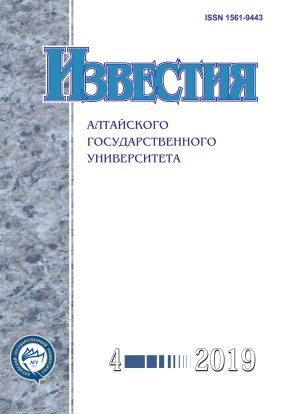Three-Dimensional Metric Lie Groups with Vectorial Torsion and Zero Curvature Tensor
УДК 517.795
Abstract
Recently, the study of (pseudo)Riemannian manifolds with different metric connections different from the Levi-Civita connection becomes relevant.A metric connection with vectorial torsion (also known as a semi-symmetric connection) is one of the often considered connections.The connection between the conformal deformations of Riemannian manifolds and metric connections with vectorial torsion on them was established in the works of K. Yano.Namely, a Riemannian manifold admits a metric connection with vectorial torsion, the curvature tensor of which is zero, if and only if it is conformally flat.Moreover, this connection plays an important role in the case of two-dimensional surfaces since, in this case, any metric connection is a connection with vectorial torsion.Thus, the problem of studying (pseudo)Riemannian manifolds with metric connection with vectorial torsion, the curvature tensor of which is zero, is arisen.This paper is devoted to solving the problem in the case of three-dimensional metric Lie groups. In addition, a mathematical model is presented that allows one to calculate the components of the curvature tensor of a metric connection with vectorial torsion in the case of metric Lie groups.
Downloads
Metrics
References
Cartan E. Sur les variétés à connexion affine et la théorie de la relativité generalisée (deuxiéme partie) // Ann. Ecole Norm. Sup.1925. Vol. 42.
Muniraja G. Manifolds Admitting a Semi-Symmetric Metric Connection and a Generalization of Schur's Theorem // Int. J. Contemp. Math. Sci. 2008. Vol. 3. No 25.
Agricola I., Thier C. The Geodesics of Metric Connections with Vectorial Torsion // Annals of Global Analysis and Geometry. 2004. Vol. 26.
Murathan C., Özgür C. Riemannian manifolds with a semi-symmetric metric connection satisfying some semisymmetry conditions // Proceedings of the Estonian Academy of Sciences. 2008. Vol. 57. No 4.
Yilmaz H.B., Zengin F.Ö., Uysal. S.A. On a Semi Symmetric Metric Connection with a Special Condition on a Riemannian Manifold // European journal of pure and applied mathematics. 2011. Vol. 4. No 2.
Zengin F.Ö., Demirbağ S.A., Uysal. S.A., Yilmaz H.B. Some vector fields on a riemannian manifold with semisymmetric metric connection // Bulletin of the Iranian Mathematical Society. 2012. Vol. 38. No 2.
Agricola I., Kraus M. Manifolds with vectorial torsion // Dierential Geometry and its Applications. 2016. Vol. 46.
Yano K. On semi-symmetric metric connection // Revue Roumame de Math. Pure et Appliquees. 1970. Vol. 15.
Sekigawa K. On some 3-dimensional curvature homogeneous spaces // Tensor N. S. 1977. Vol. 31.
Calvaruso G. Homogeneous structures on three-dimensional Lorentzian manifolds // J. Geom. Phys. 2007. Vol. 57.
Milnor J. Curvature of left invariant metric on Lie groups // Advances in mathematics. 1976. Vol. 21.
Rodionov E.D., Slavskii V.V., Chibrikova L.N. Locally conformally homogeneous pseudo-Riemannian spaces // Siberian Advances in Mathematics. 2007. Vol. 17. No 3.
Cordero L.A., Parker P.E. Left-invariant Lorentzian metrics on 3-dimensional Lie groups // Rend. Mat. 1997. Vol. 17.
Izvestiya of Altai State University is a golden publisher, as we allow self-archiving, but most importantly we are fully transparent about your rights.
Authors may present and discuss their findings ahead of publication: at biological or scientific conferences, on preprint servers, in public databases, and in blogs, wikis, tweets, and other informal communication channels.
Izvestiya of Altai State University allows authors to deposit manuscripts (currently under review or those for intended submission to Izvestiya of Altai State University) in non-commercial, pre-print servers such as ArXiv.
Authors who publish with this journal agree to the following terms:
- Authors retain copyright and grant the journal right of first publication with the work simultaneously licensed under a Creative Commons Attribution License (CC BY 4.0) that allows others to share the work with an acknowledgement of the work's authorship and initial publication in this journal.
- Authors are able to enter into separate, additional contractual arrangements for the non-exclusive distribution of the journal's published version of the work (e.g., post it to an institutional repository or publish it in a book), with an acknowledgement of its initial publication in this journal.
- Authors are permitted and encouraged to post their work online (e.g., in institutional repositories or on their website) prior to and during the submission process, as it can lead to productive exchanges, as well as earlier and greater citation of published work (See The Effect of Open Access).








